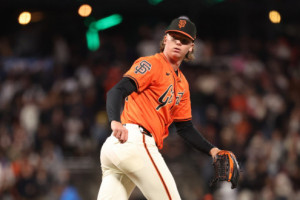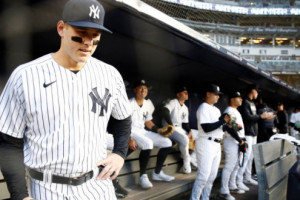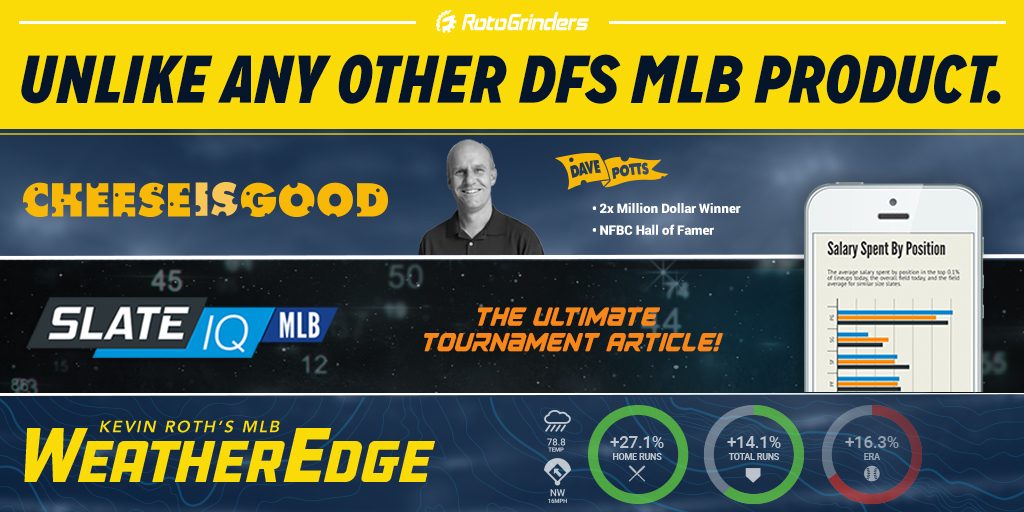10 Definitely Interesting, Possibly Helpful MLB Notes for Tuesday, June 11th
Welcome to 10 Definitely Interesting, Possibly Helpful Notes! In this column, I’ll work to uncover some interesting bits of information that might shed some light on players from that day’s slate of MLB games. This is not a picks column, nor is it a “fun facts” article – it’s something in between.
I hope you enjoy it, and I hope it helps you think about today’s MLB plays in a new way as you build your DFS lineups. Here are 10 Notes for Tuesday, June 11th.
1. Patrick Corbin isn’t getting batters to chase outside the zone as frequently in 2019; his 33.3% chase rate represents a 4.7 percent dropoff from his 2018 mark, which is the fourth-largest of any pitcher in MLB (min. 40 IP). Consequently, his strikeouts have fallen from “elite” in 2018 (30.8%) to merely “very good” in 2019 (26.8%). Even if Corbin isn’t the same guy as he was in 2018, there aren’t any slam dunk options at the high-end of Tuesday’s slate, and Corbin has the best combination of strikeouts and matchup. He’ll take on a White Sox team that, against left-handed pitching, ranks 28th in team ISO (.118) and 23rd in wOBA (.300) and strikes out at a healthy 24.9 percent clip. It’s not great, but he’s arguably the top cash option on the slate.
2. Luis Castillo’s 29.4 percent strikeout rate isn’t unique; 14 qualified pitchers have a higher K rate than his in 2019 alone. Even his 59.8 percent ground ball rate isn’t unique; since BIS began tracking batted ball data, there have been 43 instances of a pitcher (min. 100 IP) posting a ground ball rate as high as Castillo’s. Castillo is unique, though, in that he combines the two. That’s something that no pitcher has done over the course of a season since 2002. On Tuesday, Castillo makes for a fantastic tournament play in a matchup against the Indians. Cleveland has been a more dangerous offense since the return of Francisco Lindor, which could suppress his ownership a bit. But unlike many pitchers, Castillo has a weapon that makes him somewhat matchup-proof. His changeup is one of the best single pitches in baseball, and in fact, no pitch thrown at least 100 times this year has a higher swinging-strike rate than his changeup (26.8%). While guys like Patrick Corbin and Chris Paddack could draw more ownership, Castillo could end up being the highest-scoring pitcher of Tuesday’s slate.

3. Even after scuffling in his two most recent starts (five homers allowed…yikes), Chris Paddack has a sub-3.00 ERA and fewer than 2 BB/9. If he maintains those numbers (a big if, obviously, since we’re in early June), he’d be the first pitcher since Mark Fidrych (yeah, the guy who talked to the baseball while pitching) in 1976 to post that combination. Paddack has already demonstrated elite control and an ability to limit runs, and on Tuesday, he finds himself in one of the best matchups imaginable against a Giants team that is tied with the Tigers with the 27th-best wRC+ in MLB against right-handed pitching (77). Paddack has a short leash – he still hasn’t eclipsed 92 pitches in a start this year – which places him behind Corbin in terms of cash game viability. But in a great hitting environment at Oracle Park, he should have no trouble stringing together 6 innings without allowing too many runs and striking out 6-8 in the process.
3. Martin Perez over his first 10 starts of 2019: 24.1%, 2.89 ERA
Martin Perez over his last 3 starts: 10.9%, 7.30 ERA
It’s tempting to point to Perez’s three most recent starts and cry small sample. And it is, but so is the 10 starts of his improved K rate; we have a much longer sample of Perez being a low-strikeout pitcher who got by through inducing weak contact. That aspect of his game is still in tact: his 25.9 percent hard-hit balls (95+ mph exit velocity) is third-lowest of the 167 pitchers with 100 batted ball events. When he added a cutter and some velocity this offseason, though, the strikeout spiked. Maybe the league has caught up and figured out how to attack his new pitch. It’s hard to pin down the cause for Perez’s vanishing strikeouts, but on Tuesday, he gets a great litmus test, as he’ll take on a Mariners team that fans at a 26.4 percent clip against southpaws, fifth-most in MLB. His $6,700 price tag at DraftKings is very tempting, even given Perez’s recent struggles. On a day without any standout SP2 options, Perez is in play given the matchup.
5. Only one pitcher in MLB has a ground ball rate above 60 percent: Cardinals rookie Dakota Hudson at 61.4%. Only one team in MLB has a ground ball rate above 50 percent against right-handed pitching: The Miami Marlins at 50.2 percent. The pieces are adding up to create a puzzle full of ground balls and very few runs allowed. It also won’t hurt that the Cardinals infield turns 1.08 double plays per game, the most in MLB. Even with the Marlins’ high 25.0 percent K rate against righties (seventh-highest in MLB), Hudson won’t record many punchouts – his 15.3% K rate ranks 82nd of 84 qualified pitchers – but he could easily make it deep into the game. There’s very little upside here, but if we’re looking for a cheap pitcher with a high floor for cash games or to fit in a high-upside stack, Hudson makes a lot of sense.
6. Cody Bellinger has a .352 ISO against righty sliders since 2017; that’s the third-best mark in MLB behind only Mike Trout and Eric Thames. When you consider that league average ISO against sliders of the righty variety is just .149, that’s mighty impressive. Bellinger should be at an advantage on Tuesday in a matchup against Felix Pena, who throws his slider nearly half the time against left-handed batters (45.8%). Even on a slate with Mike Trout, Christian Yelich, and Coors Field, Bellinger is one of the top hitter options on the slate.

7. Only one player in MLB has a .230 ISO and under 16 percent strikeouts in 4 seasons since 2015 (min. 250 PA): Anthony Rizzo. Rizzo’s power and plate discipline combination has been at the top of MLB for a long time, but he’s upped his game to a new level in 2019, currently holding career-highs in wOBA (.399), ISO (.275), hard hits (43.5 percent). He’ll have the platoon advantage against Rockies rookie righty Pat Lambert (there’s some alliteration for you). Along with the usual suspects of Nolan Arenado versus a Lefty and Trevor Story versus a Lefty, Rizzo is a must-have Coors bat with one of the highest floors and ceilings on the slate.
8. While Rizzo will cost an arm and a leg, fellow Cub and Rockies legend Carlos Gonzalez will look to do damage in his old stomping grounds, and he’ll do it at a much cheaper price. During his tenure in Colorado, CarGo posted a .400+ wOBA in 9 out of 10 seasons for the Rockies at home against righties. If he cracks the lineup, he’s one of the best point-per-dollar plays on the slate at DraftKings at just $3,600.
9. Michael Brantley strikes out just 6.7 percent of the time against righties. That’s just 13 strikeouts for the season (to go with 8 homers…). Here’s some context: 14 hitters have struck out more than 13 times over the past two weeks against righties, and Brantley has 13 for the entire season. He’s changed uniforms, but his ability to be one of the best contact hitters in MLB hasn’t changed a bit. He’s priced down at just $4,100 at DraftKings, and with the platoon edge against Brewers right-hander Freddy Peralta, Brantley represents the prototypical cash game play: he’s going to have a good lineup spot, he’s going to hit with men on base, and he’s going to put the ball in play multiple times.
10. Above, I listed Anthony Rizzo as a rare high-power, low-strikeout hitter. Corey Seager is another, and he’s been white hot at the plate over the past month. Over the past 30 days, only three hitters (min. 100 PA) have posted a .300+ ISO with 16 percent strikeouts or fewer: Christian Yelich, Freddie Freeman, and Seager. Seager is a surprisingly affordable way of allocating shortstop funds at both DraftKings ($4,300) and FanDuel ($3,500), and he’ll have the platoon advantage against Felix Pena. Pena has long preferred facing righties (.286 career wOBA against LHBs; .333 against RHBs), which should help Seager. But really, this is just a price play, taking the savings on a guy who should be a few hundred bucks more expensive across the industry.
__________________________________________________________________________________________________________________________________
Thanks for reading! Stats from this article were pulled from RotoGrinders’ PlateIQ tool, FanGraphs, Baseball Prospectus, Baseball Savant, Brooks Baseball, and Baseball Reference.
Check back for more “10 Notes” MLB articles every Tuesday and Friday throughout the year, and feel free to leave a question or comment down below!
